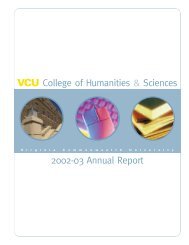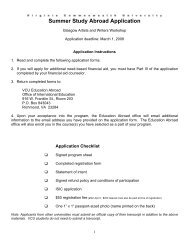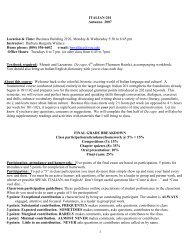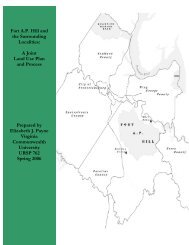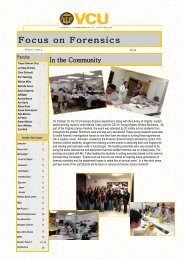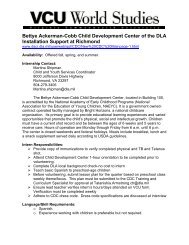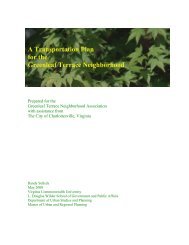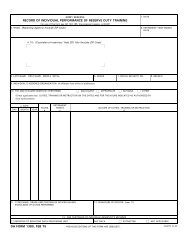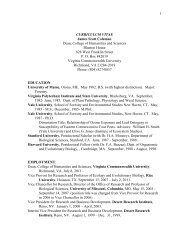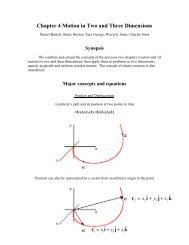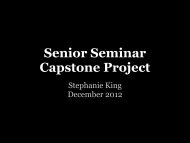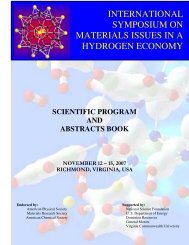Thad M. Adams, Marie Kane, & Paul S. Korinko Materials Science ...
Thad M. Adams, Marie Kane, & Paul S. Korinko Materials Science ...
Thad M. Adams, Marie Kane, & Paul S. Korinko Materials Science ...
Create successful ePaper yourself
Turn your PDF publications into a flip-book with our unique Google optimized e-Paper software.
3.00E-01<br />
2.50E-01<br />
2.00E-01<br />
1.50E-01<br />
1.00E-01<br />
5.00E-02<br />
0.00E+00<br />
MetGlas Permeation Test<br />
0 1000 2000 3000 4000 5000 6000 7000 8000<br />
Time (s)<br />
Leak 400C<br />
Perm 400 T 400C<br />
Sat 400T 400C<br />
Perm 700T 400C<br />
Sat 700T 400C<br />
Alternative <strong>Materials</strong> to Pd Membranes for Hydrogen Purification<br />
Pressure (Torr)<br />
<strong>Thad</strong> M. <strong>Adams</strong>, <strong>Marie</strong> <strong>Kane</strong>, & <strong>Paul</strong> S. <strong>Korinko</strong><br />
<strong>Materials</strong> <strong>Science</strong> and Technology<br />
Savannah River National Laboratory<br />
Prepared for the U.S. Department of Energy under Contract DE-AC09-96SR1850<br />
WSRC-STI-2007-00379
Background<br />
• DOE interested in developing low cost membrane<br />
purification technology to replace Pd based<br />
membranes<br />
• Target application is forecourt purification for<br />
distributed hydrogen production<br />
• Purity target 99.99% H2, ideally to meet SAE/ISO<br />
requirements to be defined by 2010
Membrane Properties and Technologies<br />
Membrane Properties<br />
• High flux<br />
• Low pressure drop<br />
• High contaminant tolerance<br />
– S, CO, solids, etc.<br />
• Low cost<br />
• Moderate operating<br />
temperature<br />
– 250 – 600 o C<br />
Membrane Separation<br />
Technologies<br />
• Molecular<br />
• Atomic<br />
• Ionic
Molecular Membranes<br />
• Porous media<br />
– Physical size separation<br />
• Φ H2 = 2.89 Å<br />
– Small pore ceramics, metals, etc. Ф Holes = 10 Å<br />
• Zeolites, SiC, SiO 2 , Al 2 O 3 , metals<br />
– Mean free path dependant<br />
– Flux α P H2<br />
– 99% purity achievable<br />
Oak Ridge National Laboratory
Proton Transport<br />
• Protons and electrons transported separately<br />
– Single or dual phase materials<br />
– Mixed conductor materials<br />
• Ceramic oxides<br />
• High temp (>800 o C)<br />
• Flux currently lower than desired<br />
– Cermet<br />
• Ceramic and metal composite<br />
• Higher electron flow and proton flow<br />
• May use separate membranes<br />
• Flux α fn(e - & p + conductivities)<br />
• Flux αln (P H2 , T)
Atomic Membranes<br />
• Dense metallic membrane<br />
– Thin metal sheets / tubes<br />
• Active surfaces<br />
– Dissociates H 2<br />
– H diffuses<br />
– H recombines to H 2+<br />
• May need supports<br />
– Porous metals<br />
– May be poisoned<br />
• CO, S, etc<br />
– Not thermally stable<br />
• High temp phase change<br />
• Low temp hydriding<br />
• No long range order<br />
possible<br />
– Flux α√P H2<br />
– High purity possible > 99.99%
Metallic Membrane Hydrogen Purification<br />
H-H<br />
H-H<br />
High Pressure<br />
H-H<br />
H-H<br />
C-O<br />
H-H<br />
O-C-O<br />
H-H<br />
H<br />
|<br />
H -C- H<br />
|<br />
H<br />
Absorption<br />
N-N<br />
H-<br />
H-<br />
Dissolution<br />
and<br />
Diffusion<br />
H<br />
H<br />
H<br />
H<br />
H<br />
Desorption<br />
-H<br />
-H<br />
Membrane<br />
Low Pressure<br />
H-H<br />
H-H<br />
H-H
Why Dense Metallic Membranes?<br />
• Simple to operate<br />
• Reliable—No moving parts<br />
• High purity hydrogen product—99.95% or better<br />
• Small size<br />
• Flexible designs<br />
• Cost effective—more so with non-noble metal<br />
membranes
Approach<br />
• Investigate non-precious metal membrane materials<br />
– High H 2 solubility (S)<br />
– High H 2 diffusivity (D)<br />
• High Permeability (Φ = D*S)<br />
• Bulk amorphous metals<br />
– Bulk metallic glasses (BMG)<br />
• Commercially available<br />
– Low cost<br />
– Dense metallic membranes<br />
• Aqueous and gaseous permeation testing
<strong>Materials</strong> of Interest<br />
• Pd / Pd alloys<br />
– Good solubility and diffusion<br />
characteristics<br />
– Well accepted in use<br />
– Susceptible to poisoning and<br />
embrittlement<br />
– High raw material costs<br />
• Alternatives to Pd based membranes<br />
– Pd-Coated Porous Ceramics<br />
• Pin-holes/holidays create short<br />
circuit pathways<br />
– Others investigating V and V-alloys<br />
and V-Al and V-Ni alloys<br />
• V has high solubility and<br />
diffusivity but suffers severely<br />
from embrittlement<br />
• Attempts at alloying V have not<br />
made significant decrease in<br />
embrittlement susceptibility<br />
– Group 5A-Ti-Ni Alloys<br />
• Ni-Ti alloys have been researched<br />
for decades due to their shape<br />
memory properties<br />
• NI-Ti Alloys are susceptible to H2<br />
Embrittlment and do not possess<br />
high permeability<br />
• Additions of Group 5A Metals (<br />
Nb, V, and Ta)<br />
• Nb additions have produced high<br />
permeation and good resistance<br />
to embrittlement<br />
• Duplex structure—Ni4Ti13Nb83<br />
and eutectic<br />
– Bulk Metallic Glasses<br />
• Commercially available Fe and Co<br />
based foil materials<br />
• Zr-Cu-Ni-Al-Y Bulk Metallic Glass
Ni-Ti-Group 5A Alloys<br />
Composite Membranes?<br />
Nb<br />
Zr<br />
V<br />
Ta<br />
H<br />
2<br />
Undesired<br />
contaminants or<br />
poison gases<br />
leakage through<br />
the ceramic.<br />
Pd<br />
Ceramic<br />
Pt<br />
Pinholes<br />
Dense Metallic<br />
Steward, LLNL, 1983<br />
Non-alloyed membranes highly susceptible to embrittlement
Previous Work<br />
Previous Work by Hashi, Ishikawa, Matsuda, and Aoki—Kitami Institute of Technology--Japan<br />
•<br />
Duplex Ni 30 Ti 31 Nb 39<br />
Ternary Eutectic Ni 41 Ti 42 Nb 17<br />
Permeability of Ni 30<br />
Ti 31<br />
Nb 39
Sample Preparation<br />
•Raw <strong>Materials</strong>:<br />
•99.95% Ti<br />
•99.6% Nb<br />
•99.7% V<br />
•99.99 Ni<br />
•Vacuum and Backfill with Ar<br />
•UHP Ar:
Microstructure Results<br />
Scanning Electron Microscopy<br />
Nb51-Ti28-Ni21<br />
Nb48-Ti28-Ni24<br />
Nb54-Ti28-Ni18<br />
V51-Ti28-Ni21
Microchemical Results<br />
X-ray Mapping of Nb48-Ni24-Ti28 Alloy<br />
x<br />
Element<br />
Weight%<br />
Atomic%<br />
Ti K<br />
Ni K<br />
Nb L<br />
13.4<br />
1.76<br />
84.84<br />
22.87<br />
2.45<br />
74.68<br />
Totals<br />
100
Microchemical Results<br />
X-ray Mapping of V51-Ni21-Ti28 Alloy<br />
x<br />
Element<br />
Weight%<br />
Atomic%<br />
Ti K<br />
V K<br />
Ni K<br />
19.46<br />
72.21<br />
8.33<br />
15.54<br />
65.28<br />
6.53<br />
Totals<br />
100
Devanathan Permeation Cell<br />
Sample<br />
SCE<br />
Gas Bubbler<br />
Pt Counter Electrode<br />
ASTM G148-97
Experimental Parameters<br />
• ASTM G-148-97<br />
• Devanathan permeation cell<br />
• 0.1 M sodium hydroxide solution<br />
• 22 and 50 °C<br />
• Nitrogen deaerated solution<br />
• Anode side: -0.125 V, SCE<br />
• Cathode side: 0.1, 0.5, 1.0 mA<br />
• Background stabilization, 2-24 hours
Sample Preparation<br />
• EDM from cast buttons<br />
• Size: 12.5 mm (0.5 in) diameter,<br />
0.64 mm (0.025 in) thick<br />
• Surface ground with 600 grit SiC paper<br />
• Plasma coated with Pd on either anode side or both<br />
• Contact wires spot welded on edge
Permeation Results<br />
• Platinum efficiencies 85-90% (40 °C) and 80% (22°)<br />
• Permeation currents increased with Nb concentration<br />
• V alloy showed better permeation than Nb alloys<br />
• Alloys appear to have a saturation level<br />
• No alloys failed during testing
Ni-Ti-X Permeation Curves<br />
3.0E-05<br />
2.5E-05<br />
2.0E-05<br />
Current (A)<br />
1.5E-05<br />
1.0E-05<br />
21Ni-28Ti-48Nb<br />
24Ni-28Ti-51Nb<br />
21Ni-28-Ti-54Nb<br />
24Ni-28Ti-51V<br />
5.0E-06<br />
0.0E+00<br />
0.0E+00 5.0E+03 1.0E+04 1.5E+04 2.0E+04 2.5E+04 3.0E+04<br />
Time (Sec)
Permeation Rates<br />
Material Permeation Rate (mol H2/m s)<br />
Palladium 3.26-4.25 x 10 -10<br />
Nb48 Alloy 6.58 x 10 -11 - 1.65 x 10 -10<br />
Nb51 Alloy 2.96 x 10 -10 - 6.0 x 10 -9<br />
Nb54 Alloy 3.25 x 10 -10<br />
V51 Alloy 1.0- 3.7 x 10 -9
• Tested at 250°, 300°, &<br />
400°C<br />
• Gaseous Hydrogen @ 400 &<br />
700Torr<br />
• Two Alloy Compositions<br />
Tested:<br />
– V48-Ti28-Ni24<br />
– V51-Ti28-Ni21<br />
• Lower Temp Membrane<br />
Failure<br />
• Membrane Robustness Test<br />
– 400°C @ 10Torr H2<br />
Gaseous Permeation Testing
Results—V48-Ti28-Ni24 Alloy<br />
Test Conditions<br />
•Temperature: 400°C<br />
•H2 Pressure: 700T<br />
•Thickness: 0.089cm (0.035in)<br />
2.00E+00<br />
1.80E+00<br />
1.60E+00<br />
V48-Ti28-Ni24 Permeation Test<br />
1.40E+00<br />
•SA:≅ 5 cm 2 1.20E+00<br />
1.00E+00<br />
8.00E-01<br />
Determine Permeability at Steady-State<br />
Pressure (torr)<br />
6.00E-01<br />
4.00E-01<br />
2.00E-01<br />
0.00E+00<br />
0 2 4 6 8 10 12 14<br />
Time (hr)<br />
•Slope of Saturation Data= Torr/hr—convert to mols H 2<br />
/min<br />
•Flux (J)= K/l (P feed<br />
1/2<br />
)<br />
•Flux (J)= (Sat Slope (mols H 2<br />
/min)/Area Permeating (m 2 )) = mols H 2<br />
/min m 2<br />
•l=m and P feed<br />
=Pascals and Solve for K=Permeability (mols H 2<br />
/m s Pa 1/2 )<br />
•For V48-Ti28-Ni24 Permeability = 1.0 x 10 -9 mols H 2<br />
/m s Pa 1/2
Bulk Metallic Glass Raw Permeation Data<br />
Sample #1<br />
1.20E-01<br />
1.00E-01<br />
Pressure (Torr)<br />
8.00E-02<br />
6.00E-02<br />
4.00E-02<br />
350C Lk<br />
350c 400T<br />
350C 400T S<br />
350C 700T<br />
350C 700T S<br />
400C Lk<br />
400C 400T<br />
400C 400T S<br />
400C 700T<br />
400C 700T S<br />
2.00E-02<br />
0.00E+00<br />
0 500 1000 1500 2000 2500 3000 3500 4000 4500 5000<br />
Time (s)
Initial Gaseous Hydrogen Results for Both<br />
V alloys and BMG <strong>Materials</strong><br />
Compare Favorably to Palladium<br />
Results--Comparison
Results--Comparison
XRD Results—V48-Ti28-Ni24 Alloy<br />
5000<br />
[metalground.xrdml] metal ground <strong>Adams</strong><br />
04-003-5868> Ti 0.5V 0.5 - Titanium Vanadium<br />
04-007-8828> VH 2 - Vanadium Hydride<br />
04-003-2228> Ti 0.8V 0.2 - Titanium Vanadium<br />
04-005-6101> Ti 0.11V 0.82 O - Titanium Vanadium Oxide<br />
4000<br />
Intensity(Counts)<br />
3000<br />
2000<br />
Vanadium Hydride Formation @250°C @700T<br />
1000<br />
0<br />
20 30 40 50 60<br />
Two-Theta (deg)
Summary<br />
• Dense metallic membranes are an attractive means for<br />
purification of hydrogen isotopes streams<br />
• Group 5A-Ti-Ni alloys offer the potential for a lower<br />
cost alternative to Pd-based membranes<br />
• Initial results for Nb- and V- alloys are favorable
Summary<br />
• Gaseous hydrogen testing has demonstrated permeabilities<br />
similar to Pd-alloy systems<br />
– Further understanding of robustness of these membrane materials is<br />
required<br />
• Longer term exposure to hydrogen<br />
• Some preliminary evidence at lower temps (250°C) indicate potential<br />
issue with embrittlment<br />
– Alloys could be optimized to further enhance permeability<br />
• Gaseous hydrogen testing for BMG demonstrated permeabilities<br />
like Pd-alloys<br />
– Further testing is needed,<br />
• Scaling to larger size is needed<br />
– Thermal cycling under hydrogen to demonstrate embrittlement<br />
resistance



